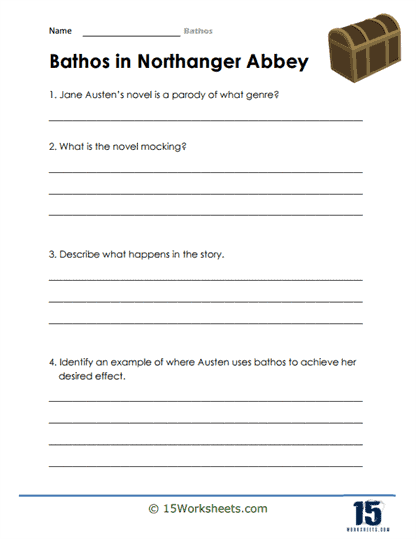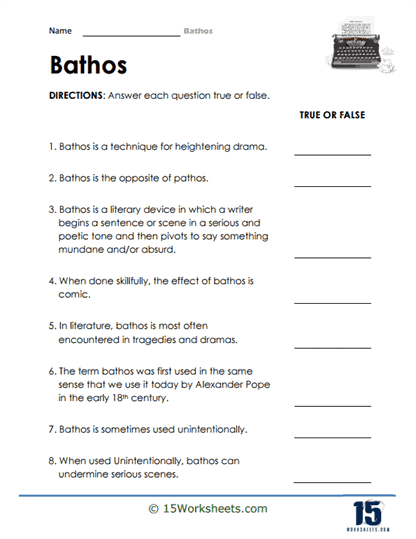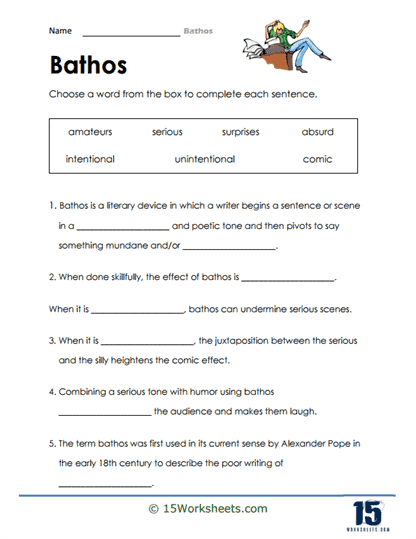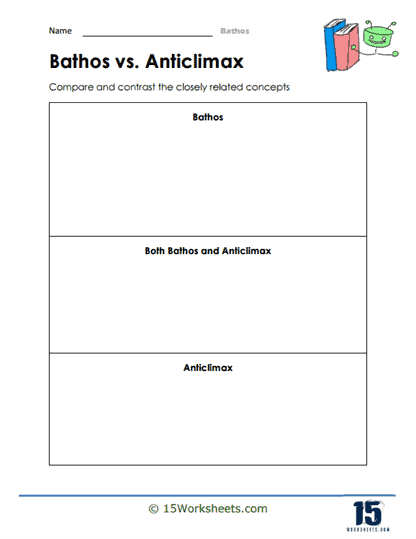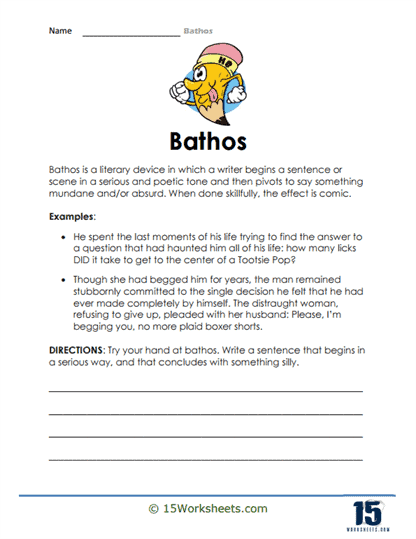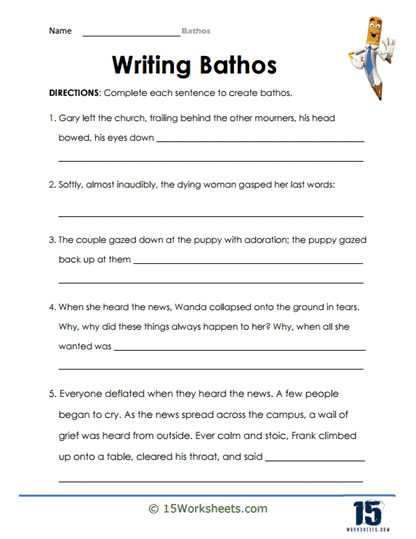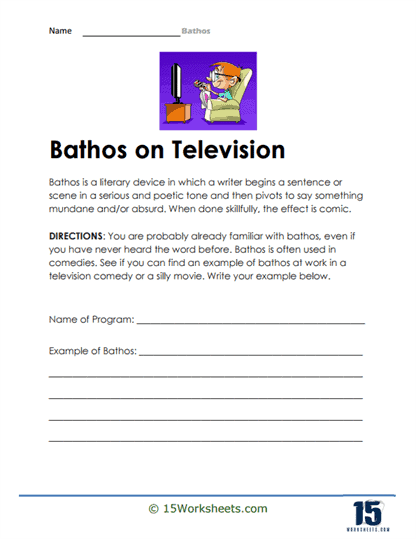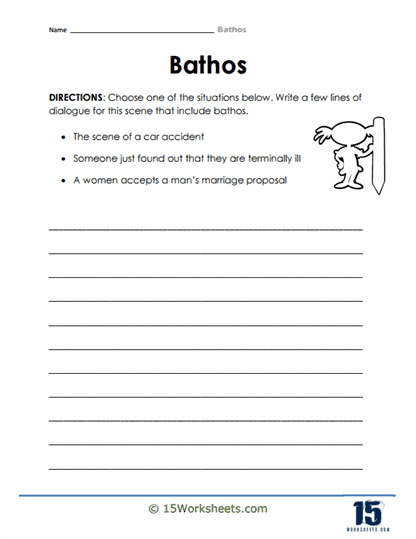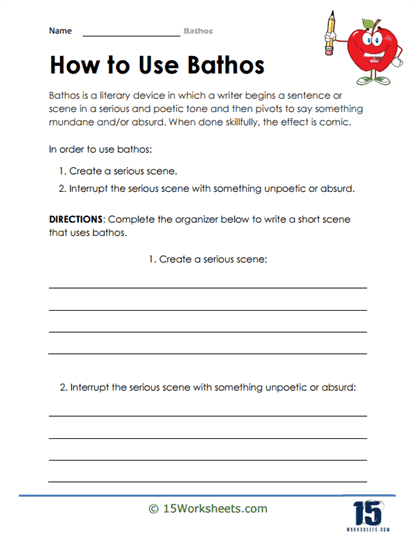Bathos Worksheets
All About These 15 Worksheets
Bathos, a rhetorical device characterized by an abrupt shift from elevated or serious language to ordinary or ridiculous language, is a fascinating and versatile aspect of language and literature. Understanding and mastering bathos not only deepens a student’s appreciation for the subtleties of humor and irony but also enhances their writing, communication, and critical thinking skills.
In a world where effective communication, humor, and emotional intelligence are essential, students must develop the ability to recognize, employ, and appreciate the art of bathos in their writing and speech. To empower students with the knowledge of bathos and its multifaceted applications, we proudly present a collection of 15 worksheets. These worksheets are meticulously designed to provide students with structured and engaging opportunities to explore, practice, and master the use of bathos.
What Is Bathos?
Bathos, in literature, is a rhetorical device used by writers to introduce an absurd or anticlimactic element into a narrative, often following a serious or profound moment. The term derives from the Greek word “bathos,” meaning depth, and it was first coined by the poet Alexander Pope in his satirical essay “Peri Bathous” in 1727 to mock writers who used high and low elements together inappropriately.
However, in contemporary usage, bathos is purposefully employed as a literary technique to create humor, surprise, or a jarring emotional effect. These worksheets aim to enhance students’ understanding of bathos by providing examples, exercises, and questions for analysis.
Students may be presented with passages from literary works that demonstrate instances of bathos. The worksheets may ask students to identify the specific lines or phrases where the shift in tone occurs and highlight the elements that create the bathetic effect. Some of these worksheets include questions that encourage students to analyze the purpose and impact of bathos in the given passages. Students may be asked to explain why the shift in tone is effective or ineffective, and how it contributes to the overall meaning or mood of the text.
Characteristics Of Bathos
The defining feature of bathos is the abrupt shift in mood it creates. Bathos appears when a writer, intentionally or unintentionally, follows a deep, important, or serious subject with a trivial, ludicrous, or inappropriate one. This sudden change can either result in comedy, as the seriousness of the previous moment is undercut, or it can cause an emotional disconnection in the reader, leading to a deeper reflection on the themes of the work.
There are several characteristics of bathos to consider:
Unexpected Shift – Bathos involves an abrupt and unexpected transition in tone from the serious to the trivial or absurd. The serious aspect sets the reader’s expectations, which are then overturned by the introduction of a lighter or inappropriate element.
Emotional Effect – Bathos can generate laughter due to the surprise or absurdity of the situation, or it can leave the reader feeling unsettled as the triviality disrupts the emotional buildup.
Juxtaposition – Bathos often involves the juxtaposition of incongruous elements, which can create a strong impression in the reader’s mind and highlight the disparity between different aspects of the work.
Satirical Intent – Bathos can serve a satirical purpose, as it can be used to mock pretentiousness, overdone sentimentality, or the overly serious.
Authors use bathos for various reasons, including to create humor, to satirize or critique, to create an emotional impact, or to challenge the reader’s expectations. Bathos can break the monotony of a serious narrative, surprise the audience, or provide comic relief in tension-filled scenarios.
Examples Of Bathos In Literature
Let’s look at two examples of bathos in literature:
“Hitchhiker’s Guide to the Galaxy” by Douglas Adams – Adams’ science fiction series is famous for its use of bathos. One notable example is when the supercomputer Deep Thought, after seven and a half million years of computation, reveals that the answer to the ultimate question of life, the universe, and everything is simply “42.” The profound buildup leading to an absurdly simple answer is a prime example of bathos.
“Hamlet” by William Shakespeare – Even Shakespeare employed bathos. In Act 5 of Hamlet, during the grave-digging scene, Hamlet holds up Yorick’s skull and contemplates death. The gravediggers, meanwhile, engage in a light-hearted conversation about legal matters, introducing a humorous and somewhat absurd element in contrast to the seriousness of Hamlet’s existential contemplation.
Bathos can have various effects on the reader. It can provide comic relief in serious situations, surprise the reader by subverting expectations, or cause the reader to reflect on the juxtaposition of the profound and the trivial. Additionally, it can be a tool to critique social norms or pretentiousness, forcing the reader to question the values and assumptions of society. Bathos, therefore, is not merely a comedic device but can be a powerful narrative technique to challenge, engage, and entertain the reader.
The Importance of Understanding Bathos For Students
Understanding bathos and its various forms is of great importance for several reasons:
- Humor and Wit: Bathos is a powerful tool for creating humor and wit in writing and speech. Proficiency in employing bathos equips students with a valuable asset for making their communication more engaging and entertaining.
- Emotional Expression: Bathos can be used to create poignant moments by juxtaposing the serious with the mundane. Students learn to convey complex emotions through clever language choices.
- Critical Analysis: Recognizing bathos in literature and media challenges students to think critically about the ways in which writers and speakers use language for effect.
- Cultural Relevance: Bathos is a common device in comedy, advertising, and pop culture. Understanding it enables students to engage more effectively with contemporary media.
This collection of Bathos worksheets is a valuable resource for educators and parents committed to nurturing effective communication, humor, and critical thinking skills in students. Proficiency in recognizing, analyzing, and employing bathos equips individuals with the tools to communicate more effectively, create engaging content, and engage with humor and irony in a meaningful way. This collection is an investment in their future success, ensuring they have the skills to convey complex ideas, make their communication more engaging, and navigate the nuances of language in a world where humor and wit play a crucial role in communication and persuasion.
Explore these Bathos worksheets today, and watch your students become skilled communicators and writers who can seamlessly transition from the profound to the ridiculous, creating memorable and impactful moments in the art of language and rhetoric.



